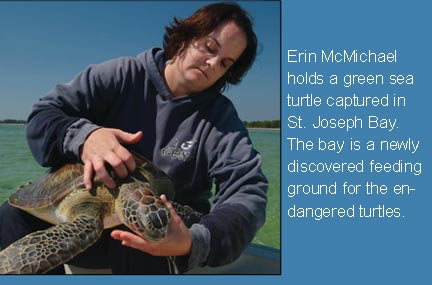|
|
 |
Researchers
Find Sea Turtle Habitat In St. Joseph Bay |
downloadable
pdf

Researchers
Find Sea Turtle Habitat Off Big Bend Coast
The waters of St. Joseph Bay are a home to a previously unknown
feeding ground for endangered green turtles, University of
Florida researchers have discovered.
A large number of young turtles come to the bay to feed on
sea grass and bulk up for the rigors of adult life, and the
area's growing human population could pose a threat to the
feeding ground, the researchers say.
"With more people using the bay for fishing and other
recreational purposes, there's some cause for concern,"
said Erin McMichael, a graduate student in interdisciplinary
ecology at UF's Institute of Food and Agricultural Sciences.
"We know that turtles can be injured by boat strikes
and fishing lines, and increased use of the bay could damage
the sea grass beds that provide a food source for the turtles."
McMichael
and Ray Carthy, a researcher at the Florida Cooperative Fish
and Wildlife Research Unit have spent the past three years
studying the use of coastal habitats by green turtles along
the coast of the Florida Panhandle, a study that included
use of satellite transmitters to track the turtles' movements.
The research unit is a cooperative effort jointly funded by
UF, the Florida Fish and Wildlife Conservation Commission
and the United States Geological Survey. The researchers presented
their studies at the International Sea Turtle Symposium in
Costa Rica earlier this year.
Once plentiful in tropical and subtropical oceans around the
world, green turtles have been decimated by centuries of human
activity. The docile reptiles, which can grow to weights of
more than 200 pounds, were once widely hunted for their meat
and leathery skin. They still face a number of environmental
threats, including pollution, fishing-related injuries and
development of beaches used nesting grounds. Though green
turtles are still found in the world's warmer climes —
including much of the U.S. Atlantic and Pacific coasts and
all of the Gulf of Mexico coast — the turtles are now
considered threatened throughout much of their range, and
are listed as endangered in Florida.
For most people, mention of sea turtles brings to mind the
image of hatchlings emerging from nests on the beach and struggling
toward the ocean, but green turtles lead complex lives largely
unseen by humans. In their early years, they ride ocean currents
for hundreds of miles in seaweed mats, feeding on smaller
animals and fish eggs. As they approach maturity, the turtles
settle in shallow waters near coasts, where they feed on sea
grass. Full-grown turtles spend their lives in various coastal
feeding areas, returning to the beach to lay their eggs.
But much is still unknown about the details of the turtle
life cycle and the travels of different turtle populations.
In early 2001, Carthy and McMichael set out to fill some of
the gaps in that knowledge. Their plan was to capture and
tag green turtles in St. Joseph Bay, to track their movements,
look at their use of habitat and measure their growth upon
recapture.
While the researchers were awaiting permits to conduct the
captures, the unexpected happened: Nearly 400 green turtles,
stunned by the cold, washed up on the shores of the bay. Small
numbers of stunned turtles routinely turn up on Florida shores
during cold spells, but this was one of the largest cold-stunning
events ever recorded in the US.
Most of the stunned turtles were rehabilitated, tagged by
state wildlife officials, and released into the Gulf of Mexico,
where the water is warmer. Carthy and McMichael have since
recaptured 43 of the turtles in St. Joseph Bay, indicating
that their presence there in 2001 was more than a fluke.
"There has been some speculation that the turtles enter
the bay, which has a relatively small entrance, and can't
find their way out again," McMichael said. "But
I think our data show they're not just lost. If you take them
out of the bay, they'll come back. We have been presented
with an amazingly rare opportunity to examine the effects
of cold-stunnings on green turtle growth and behavior."
The researchers say the bay is a temporary home for turtle
"teenagers" — juveniles between 5 and 15 years
old that live in shallow coastal waters and feed off sea grasses
while growing to maturity. One reason for the attraction,
the researchers say, is the relatively undeveloped nature
of St. Joseph Bay, which is just now beginning to see the
kind of development boom that has lined much of Florida's
coast with resorts and neighborhoods.
"With the development that already exists along the coast,
there aren't many feeding grounds that are left undisturbed,"
Carthy said.
Allen Foley, a wildlife biologist for the Florida Fish and
Wildlife Conservation Commission, said the scientific community
was already aware of similar feeding grounds off the Florida's
Atlantic and southwest coasts, though the UF researchers'
finding is a first for the relatively undeveloped northwest.
"Nobody had any idea that the Panhandle had such a large
assemblage of juvenile green turtles, but this study confirms
that it does," Foley said.
The finding emphasizes the need for responsible development
around the bay, the researchers say.
"This time we have a chance to get it right," McMichael
said. "St. Joseph Bay is one of the most pristine bodies
of water in Florida. In the rush to develop the Panhandle,
we need to be careful not to damage it."
Erin McMichael, emcmich@aol.com
by
Tim Lockette
|

